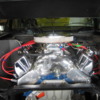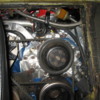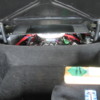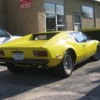Well the rebuild has 225 miles on it now and I noticed a small leak at the head gasket on the 1-4 bank at the back near the oil sender. Since the cleveland does not pass coolant throught the manifold I feared the worse, the head gasket. The coolant would show up after a hard workout for a bit. There is no smoke at all and runs perfectly. To make sure of the location I placed a small piece of white paper towel at the mating surface between the head and block as held it in place with duct tape. Went out for a "fun" ride and took off the tape and the towel was indeed wet with coolant. I then took off the rockers and retorque the head. I know that I had torqued them to 110lbs (recomended by Edlebrock when using 1/2" bolts) but when retorqueing them I was able to turn them a bit over a 1/4 turn to achieve the 110lbs. My question is regarding the rocker adjustment. Since the engine has been run do the lifters (I have roller hydraulic) still have oil under pressure in them? Do I just adjust them like I did when they were dry? On a side note. When I told the machine shop that I had Edlebrock aluminum heads they told me of a guy that had rebuilt his engine for a boat and use Edlebrock heads and on his first run blew a head gasket. They suggested that I get them checked for straightness. I brought them in and they checked them, but only between the cylinders not at the ends where the water passage is. I hope that the retouque will solve the problem, this engine runs too good to have a stinkin problem like this. I can post pictures when I get home.
Thanks
Original Post





